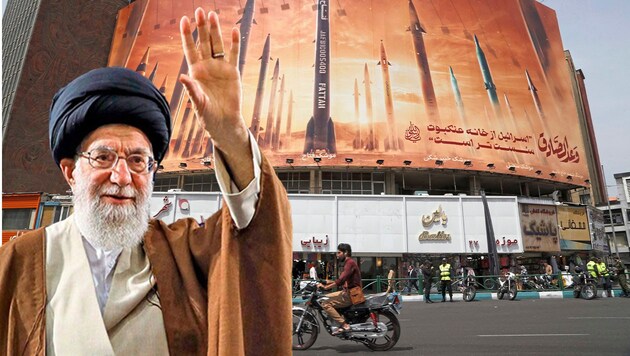45 years of warmongering
Mullah dictatorship Iran: fateful hours for the regime
Iran's mullah regime is 45 years old, its Supreme Leader Ali Khamenei 35 years in power and 85 years old as of Friday. No dictatorship in history has not moved or changed a single millimeter in such a long time. But now fate is knocking at the door. How does this clerical dictatorship work? How has it been able to hold on for so long?
Iranians are Shiites - a minority in the large Sunni Islamic world. The state religion in Iran itself has retained old national elements such as the solar calendar and the spring New Year.
Shiism has experienced a history of religious oppression. The faith is particularly strong in the large rural areas of Iran. The forced westernization under the last Shah, Reza Pahlavi (1919 to 1980), led to alienation among large sections of the people.
Supreme Mullah is 85 years old, 35 years in power
This brought the militant cleric Ayatollah Khomeini to power through a revolution in 1979. He tipped Iranian society into religious fundamentalism, even fanaticism.
The goal of this Shiite mullah regime is to achieve historical parity with the Sunni world, which in the immediate vicinity are the Arabs, represented by Saudi Arabia. To this end, anti-Zionism against Israel, which did not previously exist in Iran, has been and continues to be fueled.
Iran's regime is practically a military dictatorship
Through maximum political and strategic mistakes by the USA, the Iranian regime has constantly gained new strength and is today practically a military dictatorship of the Revolutionary Guards: The chronicle: US debacle in Afghanistan; questionable invasion of Iraq; but then the opposite in Syria, where the Assad regime crushed the Arab Spring with the help of the Russians, and birth of the IS caliphate in Syria and Iraq.
Iran thus succeeded in placing a "Shiite crescent" over the Middle Eastern map: it extends from the Shiite Hezbollah in Lebanon to the (Sunni) Hamas in Gaza, the Al-Alawite (Shiite, note) Assad regime in Syria and the Shiite Houthis in Yemen. Tehran has waged war against Israel through these "proxies" without becoming involved in hostilities itself.
Russia and China back Iran
The unintentional survival aid for the Iranian regime has manifested itself since the Ukraine war in the anti-US alliance Iran-Russia-China. With these two powers behind them, the mullahs finally dared to attack Israel directly. The sanctions are apparently going nowhere.
In these fateful hours, the Iranian regime is also facing a succession, as the leader of the state, revolution and religion, Khamenei, turned 85 on Friday. He has undergone an operation.
To this day, Khamenei is considered untouchable and criticism of his person is not tolerated. Nevertheless, in this clerical dictatorship, which has repeatedly experienced serious waves of protest against the Islamic system of rule for years, a discussion about the time after Khamenei is simmering.
Many Iranians are angry and disillusioned
In recent years, the Supreme Leader has attracted a great deal of anger and many are angry, disillusioned and see no prospects for themselves in this country. What they would like to see, especially among the young and urban population, is a collapse of the system.
How is a succession organized? A so-called council of experts would choose the successor in the event of death. This body consists of 88 arch-conservative clerics.
Mullah dictatorship lacks "crown prince" with authority
The turbaned men are jealous of each other and even quarrel. Some are under house arrest. Threats from outside bring them together for a short time. In any case, no "crown prince" with authority is emerging. The most likely candidate would be (Minister) President Ebrahim Raisi.
The Revolutionary Guards have not only been militarily upgraded in recent years, they have also expanded their social and economic influence. Today, they are regarded as an economic power, with interests in hotel chains and airlines, among others.
Danger of coups and protests
In the transition phase, the danger of coups and protests increases for a regime.a journalist in Tehran sees the country in a critical transition period. "Such phases can quickly lead to instability. This increases the risk of intensified power struggles, coup attempts or a coup d'état."






















Kommentare
Willkommen in unserer Community! Eingehende Beiträge werden geprüft und anschließend veröffentlicht. Bitte achten Sie auf Einhaltung unserer Netiquette und AGB. Für ausführliche Diskussionen steht Ihnen ebenso das krone.at-Forum zur Verfügung. Hier können Sie das Community-Team via unserer Melde- und Abhilfestelle kontaktieren.
User-Beiträge geben nicht notwendigerweise die Meinung des Betreibers/der Redaktion bzw. von Krone Multimedia (KMM) wieder. In diesem Sinne distanziert sich die Redaktion/der Betreiber von den Inhalten in diesem Diskussionsforum. KMM behält sich insbesondere vor, gegen geltendes Recht verstoßende, den guten Sitten oder der Netiquette widersprechende bzw. dem Ansehen von KMM zuwiderlaufende Beiträge zu löschen, diesbezüglichen Schadenersatz gegenüber dem betreffenden User geltend zu machen, die Nutzer-Daten zu Zwecken der Rechtsverfolgung zu verwenden und strafrechtlich relevante Beiträge zur Anzeige zu bringen (siehe auch AGB). Hier können Sie das Community-Team via unserer Melde- und Abhilfestelle kontaktieren.